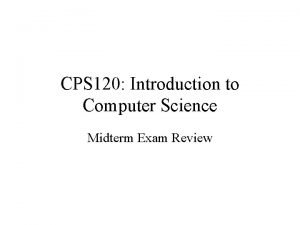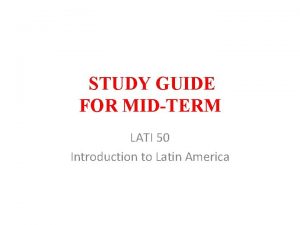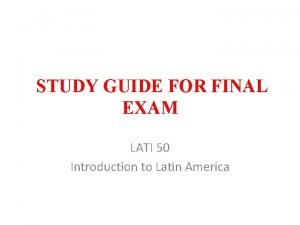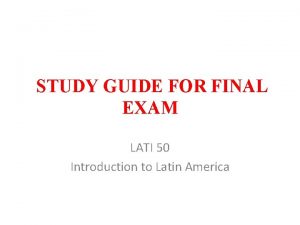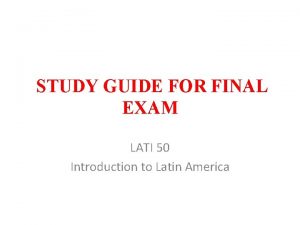STUDY GUIDE FOR MIDTERM LATI 50 Introduction to






- Slides: 6

STUDY GUIDE FOR MID-TERM LATI 50 Introduction to Latin America

ATTENDANCE AT SECTIONS • An important component of course grade, as follows: – 9 -10 absences (failure in course) – 5 -8 absences (penalty = 2 letter grades) – 3 -4 absences (penalty = 1 letter grade) – 1 -2 absences (OK but you must explain absences to your TA) • Consult with your TA if there is any confusion or miscommunication about attendance!

ABOUT THE MIDTERM (i) • Coverage: Weeks 1 -5 • Grade share: 33% (without optional paper) • Format: closed-book exam (no electronic devices) • Date: Thursday, February 23 (in class) • Duration: 80 minutes (2: 00 -3: 20 pm) • Bring blue books and writing materials

ABOUT THE MIDTERM (ii) • Readings: – Modern Latin America, introduction + chapters 1 -5, 7 -10, 12 -13 – MLA website, Documents 3, 6, 14 – García Márquez, Chronicle of a Death Foretold • Videos: – “Garden of the Forking Paths” – “Fire in the Mind” • Class Notes: – Lectures 1 -10

STUDY GUIDE (a) Identify and state the significance of: – – – Santiago Nasar Bayardo San Román Francisco Madero Evita Perón The “boom” ISI César Augusto Sandino Mestizaje Platt Amendment NAFTA Bureaucratic-authoritarian regimes Augusto Pinochet

STUDY GUIDE (b) • Compare the Spanish American path to independence with that of Brazil. What difference did it make? • How does Chronicle of a Death Foretold exemplify the phenomenon of “magical realism”? • Compare the Mexican Revolution with the Cuban Revolution. • Compare economic strategies in Chile and Argentina. • Describe Latin America’s patterns of democratization during the course of the twentieth century. What are the implications of these trends?


